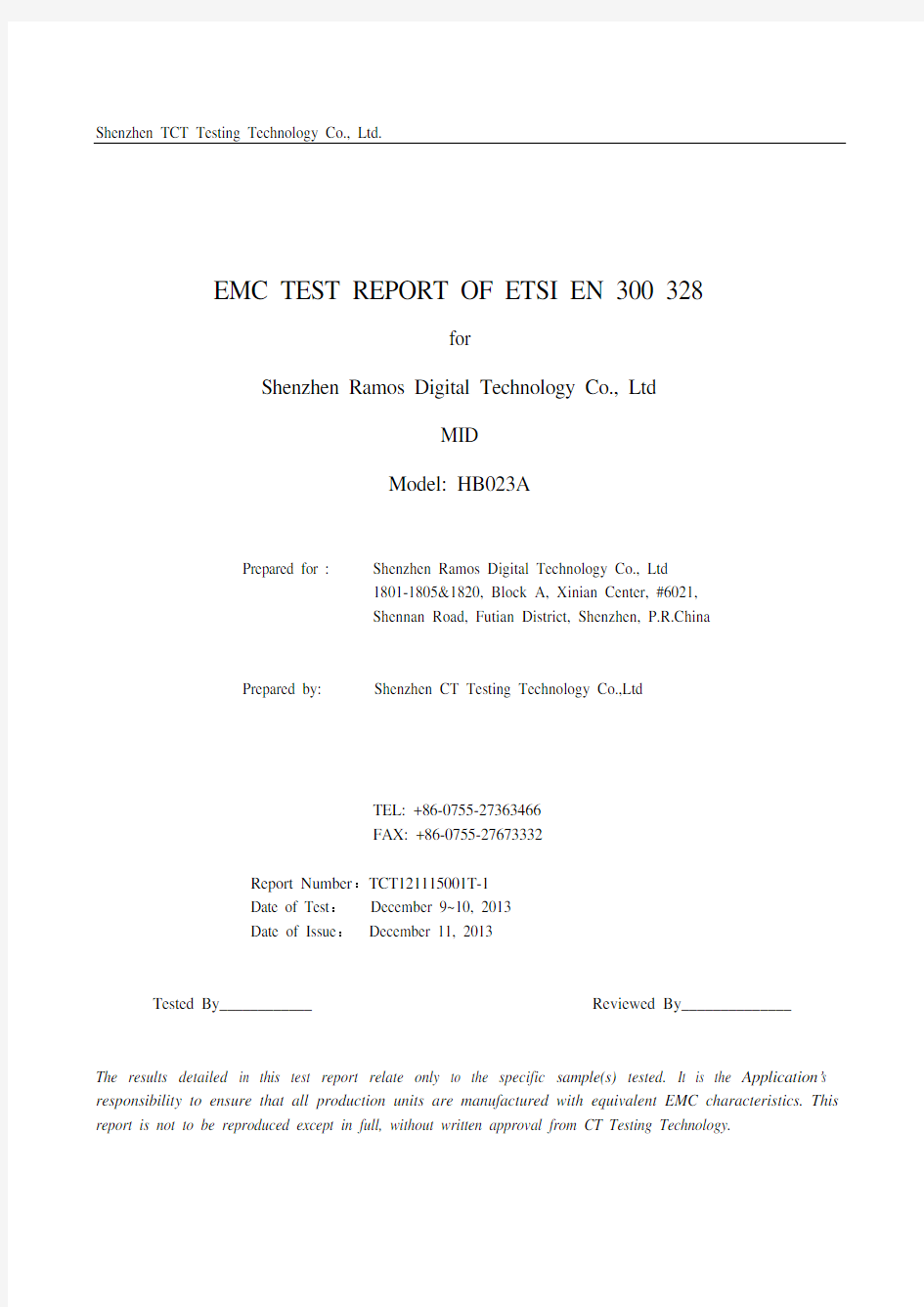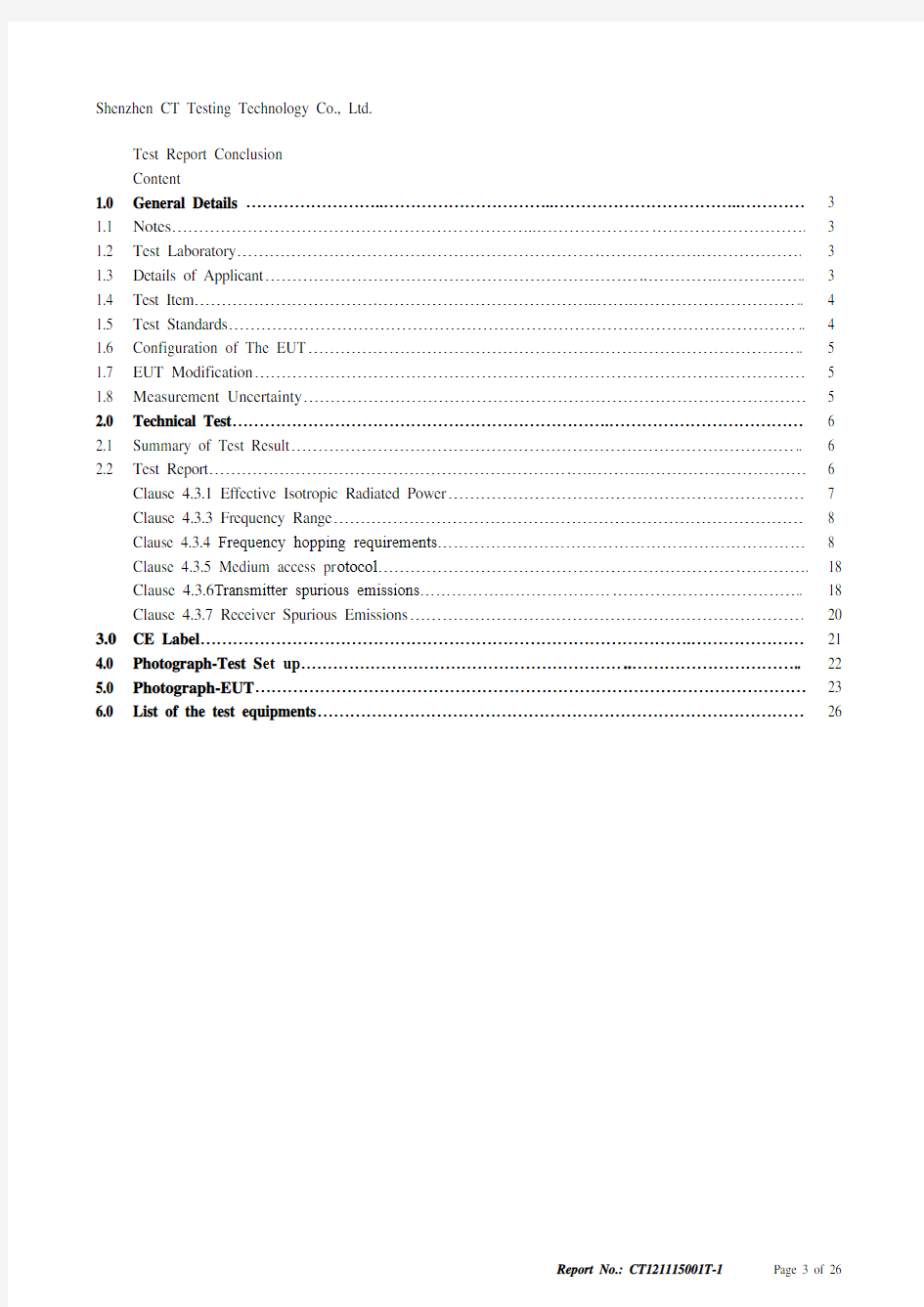

Shenzhen TCT Testing Technology Co., Ltd.
EMC TEST REPORT OF ETSI EN 300 328
for
Shenzhen Ramos Digital Technology Co., Ltd
MID
Model: HB023A
Prepared for : Shenzhen Ramos Digital Technology Co., Ltd
1801-1805&1820, Block A, Xinian Center, #6021,
Shennan Road, Futian District, Shenzhen, P.R.China
Prepared by: Shenzhen CT Testing Technology Co.,Ltd
TEL: +86-0755-********
FAX: +86-0755-********
Report Number:TCT121115001T-1
Date of Test:December 9~10, 2013
Date of Issue:December 11, 2013
Tested By____________ Reviewed By______________
The results detailed in this test report relate only to the specific sample(s) tested. It is the Application’s responsibility to ensure that all production units are manufactured with equivalent EMC characteristics. This report is not to be reproduced except in full, without written approval from CT Testing Technology.
Test Report Conclusion
Content
1.0 General Details (3)
1.1 Notes (3)
1.2 Test Laboratory (3)
1.3 Details of Applicant (3)
1.4 Test Item (4)
1.5 Test Standards (4)
1.6 Configuration of The EUT (5)
1.7 EUT Modification (5)
1.8 Measurement Uncertainty (5)
2.0 Technical Test (6)
2.1 Summary of Test Result (6)
2.2 Test Report (6)
Clause 4.3.1 Effective Isotropic Radiated Power (7)
Clause 4.3.3 Frequency Range (8)
Clause 4.3.4 Frequency hopping requirements (8)
Clause 4.3.5 Medium access pr otocol (18)
Clause 4.3.6Transmitter spurious emissions (18)
Clause 4.3.7 Receiver Spurious Emissions (20)
3.0CE Label (21)
4.0 Photograph-Test S et up (22)
5.0 Photograph-EUT (23)
6.0 List of the test equipments (26)
1.General Information
1.1 Notes
The test results of this report relate exclusively to the test item specified in 1.5. The CT- Lab does not assume Responsibility for any conclusions and generalizations drawn from the test results with regard to other specimens or samples of the type of the equipment represented by the test item. The test report may only be reproduced or published in full. Reproduction or publication of extracts from the report requires the prior written approval of the TCT- Lab.
1.2 Testing Laboratory
Shenzhen CT Testing Technology Co., Ltd.
Site Listed with Industry Canada of Ottawa, Canada
Registration Number: IC:
For 3m chamber
1.3 Details of Applicant
Name: Shenzhen Ramos Digital Technology Co., Ltd
Address: 1801-1805&1820, Block A, Xinian Center, #6021,
Shennan Road, Futian
1.4 Test Item
Name: Shenzhen Bluekeypad Technology Co., Ltd
Address: 16B, Yongfu, Guoqi Building, Shangbu South Road, Futian District, Shenzhen, China
Brand Name: N/A
Model No.: HB023A
Additional Model No.: BL-1030,BL-1030-2,BL-1028,BL-1028-2,BL-1022,BL-1022-2,HB023B,
BL-1068,BL-1068-2,BL-1090,BL-1090-2
Additional Brand Name: N/A
Description: scissors feet ABS bluetooth keyboard
Additional Information
Frequency: 2402-2480 MHz
Number of Channels: 79
Antenna Designation: A PCB printed antenna, and the maximum Gain of this antenna is 2.5dBi
Type of Modulation: FHSS
Extreme Temp. Tolerance: -20℃to 55℃
Note: Classification according to CEPT/ERC Recommendation 70-03 & ETSI EN301 489-17 v 2.1.1 (2009-05) 1.5 Test Standards
ETSI EN 300 328 v 1.7.1 (2006-10)
Electromagnetic compatibility and Radio spectrum Matters(ERM);
Wideband Transmission systems;
Data transmission equipment operating in the 2.4GHz ISM band and using spread spectrum modulation techniques;
Harmonized EN covering essential requirements under article 3.2 of the R&TTE Directive
Note: All radiated measurements were made in all three orthogonal planes. The values reported are the maximum values.
1.6 Configuration of the EUT
The EUT was configured according to CISPR16. All interface ports were connected to the appropriate peripherals. All peripherals and cables are listed below.
A.EUT
B.Peripherals
C.EUT Exercise
The EUT (Transmitter) was operated in the engineering mode to fix the Tx frequency that was for the purpose of the measurements.
1.7 EUT Modifications
No modification by Shenzhen TCT Testing Technology Co., Ltd
1.8 Measurement Uncertainty(95% confidence levels, k=2)
2. Technical Test
2.1Summary of Test Results
2.2 Test Report
Test Report Reference
Note: The clause numbers are referenced to ETSI EN 300 328 V 1.7.1(2006-10)
Clause 4.3.1 Effective Isotropic Radiated Power (Conducted)
Remarks:
A temporary antenna connector provided when this test item was done. And the EUT was connected to the power meter through the connector.
EIRP is calculated by method described under sub clause 7.2.1.2, using following formulae;
P=A+G+10 log (1/x);
Where:
A=Average Power (measured)
G= Antenna Gain= 2.5dBi
x= Duty Cycle=0.337 (measured)
Av: Average Power During Burst
Clause 4.3.3 Frequency Range
Clause 4.3.4 Frequency hopping requirements
The Frequency Hopping systems used by the EUT is the type of Adaptive Frequency Hopping systems
Actual = Reading × (Hopping rate / Number of channels) × Test period Test period = 0.4 [seconds / channel] × 79 [channel] = 31.6 [seconds] NOTE: The EUT makes worst case 1600 hops per second or 1 time slot has a length of 625μs with 79 channels. A DH5 Packet needs 5 time slot for transmitting and 1 time slot for receiving. Then the EUT makes worst case 266.667 hops per second with 79 channels. It also meet the requirement of clause 4.3.4.3. Each hopping channel of the hopping sequence is occupied at least once during a period not exceeding four times the product of the dwell time per hop and the number of channels.
Test Plots:
Low Channel: DH5 (Under test mode)
Middle Channel: DH5 (Under test mode)
High Channel:DH5 (Under test mode)
Low Channel: DH3(Under test Mode)
Middle Channel: DH3(Under test Mode)
High Channel: DH3 (Under test mode)
Low Channel: DH1 (Under test mode)
Middle Channel: DH1 (Under test mode)
High Channel: DH1: (Under test mode)
4.3.4.2 Hopping channel
EUT scissors feet ABS bluetooth
keyboard
Model HB023A Mode Keep Transmitting Input Voltage DC 3.7V Temperature 26 deg. C, Humidity 53% RH
Channel Channel Frequency
(MHz)
20 dB Channel Bandwidth
(kHz)
Maximum Limit
(kHz)
Pass/
Fail
Low 2402 1102.2 -- Pass Middle 2441 1112.2 -- Pass
High 2480 1092.2 -- Pass
Test Figure:
1. Low Channel
2. Middle Channel
3. High Channel
EUT scissors feet ABS bluetooth
keyboard
Model HB023A Mode Keeping Transmitting Input V oltage DC3.7V Temperature 26 deg. C, Humidity 53% RH
Channel Channel Frequency
(MHz)
Carrier Frequency
Separation
Limit
Pass/ Fail
High 2480 1.002MHz ≥1MHz Pass
Test Plots
High Channel
Clause 4.3.4.3 Hopping sequence
EUT scissors feet ABS bluetooth
Model HB023A
keyboard
Mode Keeping Transmitting Input V oltage DC3.7V
Temperature 26 deg. C, Humidity 53% RH
Operating Frequency
Pass/ Fail
Number of hopping channels Limit
2402-2480MHz 79 ≥ 15Pass
Clause 4.3.5 Medium access protocol
A medium access protocol is a mechanism designed to facilitate spectrum sharing with other devices in a wireless network.
Result: A medium access protocol is implemented by the equipment
Clause 4.3.6 Spurious Emissions
(Radiated)
Transmitter Operating
Note:
1.Measurements were done on middle & high channels, but depicting the worst case are submitted in the report.
2.The spurious emissions were done with different settings, using the relevant pre-amplifiers for the relevant
frequency ranges.
Note: NF=No Significant Peak was Found Please see the following pages for details.
Clause 4.3.7 Receiver Spurious Emissions
(Radiated)
Note:
1. Measurements were conducted on low & high channels, but the worst case was submitted in the report only.
2. The receiver spurious emissions were conducted with different settings, using the relevant pre-amplifiers for the relevant frequency ranges.
NF=No significant peak noise was found